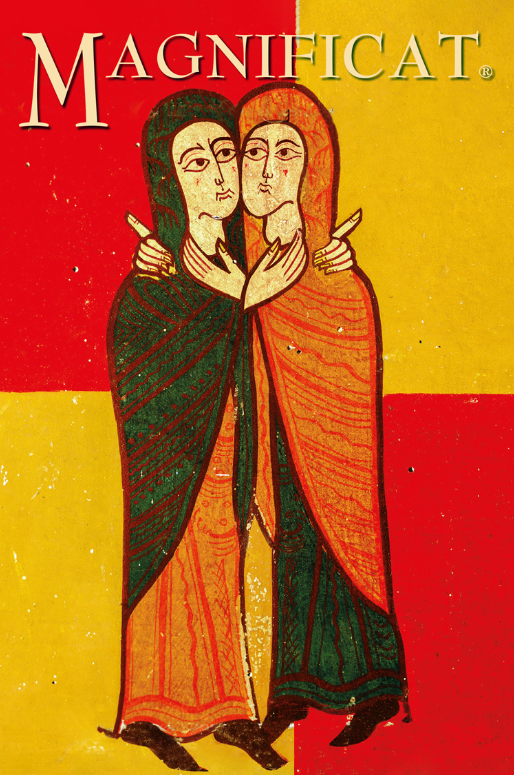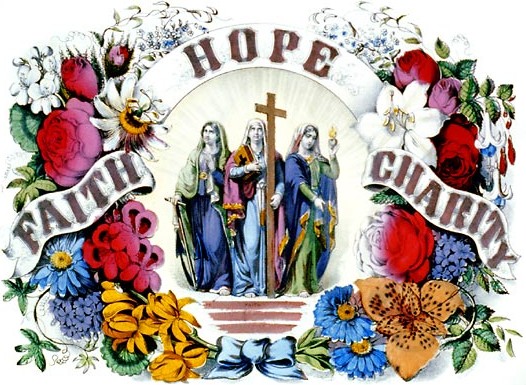I have been observing this cover of the Magnificat magazine for weeks during daily Mass. A devout woman who sits in front of me always lays it upon the empty chair next to her. It moved me deeply, insinuating a Spanish sensibility that drew me in. I expressed to her how much I enjoyed the image and she insisted I take the Magnificat with me and read about the cover. I did and was moved, feeling the need to share.

This work of art was produced in the late 12th century to decorate the frontispiece of the altar in a remote little mountain church on the borders of the Catalan Pyrenees (Spain), in San Andrés de Sagas. The anonymous artist painted it with distemper paint on a panel made of cherry wood. In order to paint with distemper, the artist began by preparing his different-colored pigments in the form of very fine powders. Then he coated the support with several successive layers of a sort of plaster. Next he “thinned” with water the pigments in the desired quantity so as to use them immediately, adding a sticky substance like starch. He then had to paint rapidly, indeed, with a very sure hand, because the prepared surface immediately absorbed the paint and dried quickly; this technique had a low tolerance for superimpositions or do-overs.
This Visitation dates from the very late 12th century, when Catalan Romanesque art, which at first had been influenced by the Byzantine-Lombard style, underwent an original development, ending (as we see here) in the inspired adoption of the “clear line.” This graphic language—which became necessary as early as the 11th century for the production of leaded stained-glass windows—would be adopted and theoretically defended in the mid-20th century by the ingenious Belgian cartoonist Hergé, the creator of Tintin, in response to the technical constraints imposed at the time by the process of printing comic strips in color. This language assumes that each element is delineated by a black line of constant thickness, forming a cell that is destined to receive a given color, without gradations of intensity or shading. This stroke, this clear line, bears the full responsibility not only for drawing the objects and situating them intelligibly, but also for expressing emotions, and finally for giving them the meaning (here, a theological one) that the artist intends to confer on the image he issues.
We see that here the artist more than adequately satisfied the specifications, with an ingenious economy of method: he went so far as to place the scene in a purely graphic setting so as to give the idea that it has at all times and in all places a universal and eschatological dimension—a meaning that transcends its anecdotal historicity. The moment of the image is the canticle of the Magnificat. Cheek to cheek, looking each other in the eyes, with their hands opened toward the Father in a unique gesture of praise that outlines the dove of the Holy Spirit, Mary and Elizabeth now form one body and one soul in their praise and thanksgiving. Elizabeth’s head, as though enlarged by contact with her cousin’s, testifies that she is the one who has just paid homage to Mary, “blessed among women.”
May this streamlined image inspire us with the holy humility that will enable us to believe the unthinkable: truly the Father wishes to make our lives into marvels, each according to his or her own vocation. And he wants to do this in a way not essentially unlike the way in which he worked marvels in the life of the Most Blessed Virgin Mary, enabling her to bring into the world, by the action of the Holy Spirit, the Love of God who is Jesus our Savior, the Son of God.
How could that happen for each of us? The Little Flower had indeed started to plumb this great mystery when she said to Jesus, in the form of a Magnificat: “Oh, Lord, it is because you wanted to give me this grace that you made your new commandment. Oh! how I love this new commandment since it gives me the assurance that your will is to love in me all those you command me to love!“ (Manuscript C). All that remains is for us, in a suitably childlike spirit, to take Saint John as our authority (1 Jn 4:12) and to dare to conclude: If we love one another as Jesus loved us, in this communion of the Holy Spirit, God dwells in us and in us his love reaches its perfection. –Pierre-Marie Dumont
The Prayer of Mary
My soul proclaims the greatness of the Lord,
my spirit rejoices in God my Savior
for he has looked with favor on his lowly servant.
From this day all generations will call me blessed:
the Almighty has done great things for me,
and holy is his Name.
He has mercy on those who fear him
in every generation.
He has shown the strength of his arm,
he has scattered the proud in their conceit.
He has cast down the mighty from their thrones,
and has lifted up the lowly.
He has filled the hungry with good things,
and the rich he has sent away empty.
He has come to the help of his servant Israel
for he remembered his promise of mercy,
the promise he made to our fathers,
to Abraham and his children forever.
(Lk 1: 46-55)
Magnificat anima mea Dominum;
Et exultavit spiritus meus in Deo salutari meo,
Quia respexit humilitatem ancillae suae; ecce enim ex hoc beatam me dicent omnes generationes.
Quia fecit mihi magna qui potens est, et sanctum nomen ejus, Et misericordia ejus a progenie in progenies timentibus eum.
Fecit potentiam brachio suo;
Dispersit superbos mente cordis sui.
Deposuit potentes de sede, et exaltavit humiles.
Esurientes implevit bonis, et divites dimisit inanes.
Sucepit Israel, puerum suum, recordatus misericordiae suae, Sicut locutus est ad patres nostros, Abraham et semeni ejus in saecula.


